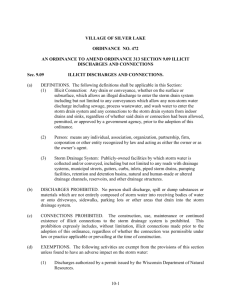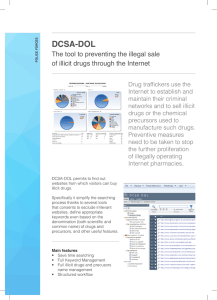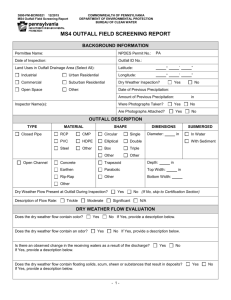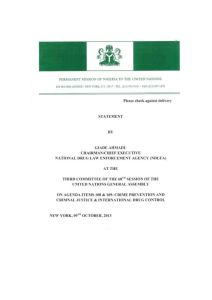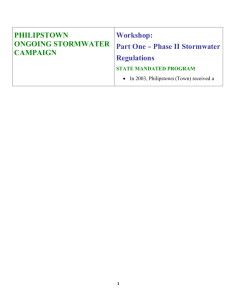Standard Operating Procedures Central Massachusetts Regional
advertisement
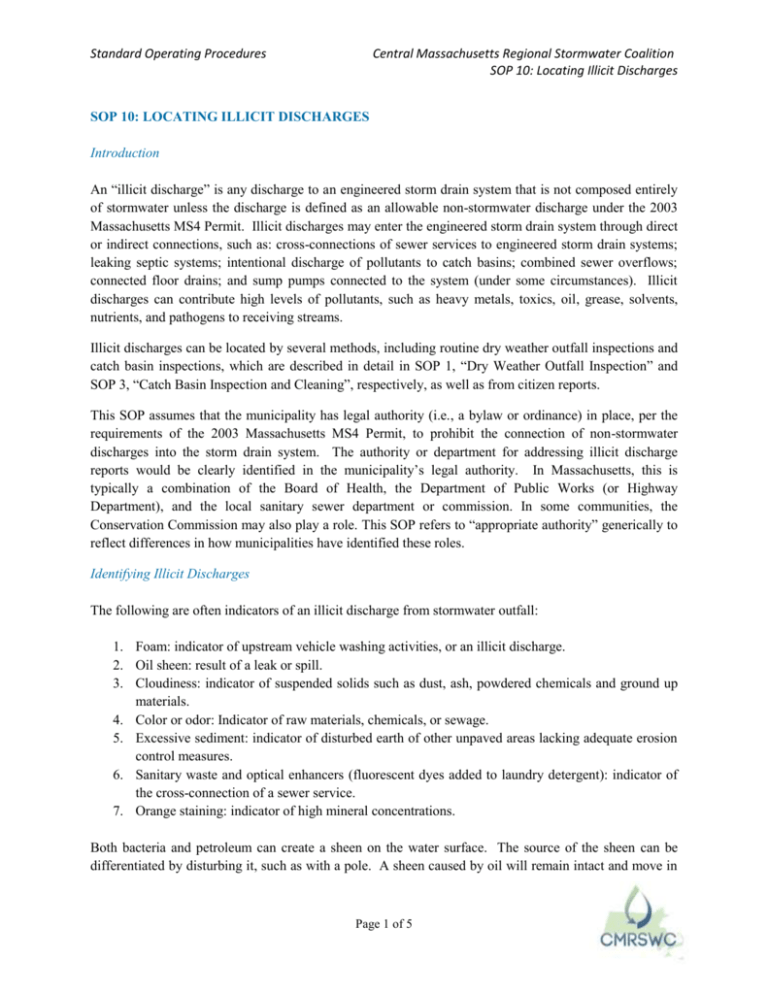
Standard Operating Procedures Central Massachusetts Regional Stormwater Coalition SOP 10: Locating Illicit Discharges SOP 10: LOCATING ILLICIT DISCHARGES Introduction An “illicit discharge” is any discharge to an engineered storm drain system that is not composed entirely of stormwater unless the discharge is defined as an allowable non-stormwater discharge under the 2003 Massachusetts MS4 Permit. Illicit discharges may enter the engineered storm drain system through direct or indirect connections, such as: cross-connections of sewer services to engineered storm drain systems; leaking septic systems; intentional discharge of pollutants to catch basins; combined sewer overflows; connected floor drains; and sump pumps connected to the system (under some circumstances). Illicit discharges can contribute high levels of pollutants, such as heavy metals, toxics, oil, grease, solvents, nutrients, and pathogens to receiving streams. Illicit discharges can be located by several methods, including routine dry weather outfall inspections and catch basin inspections, which are described in detail in SOP 1, “Dry Weather Outfall Inspection” and SOP 3, “Catch Basin Inspection and Cleaning”, respectively, as well as from citizen reports. This SOP assumes that the municipality has legal authority (i.e., a bylaw or ordinance) in place, per the requirements of the 2003 Massachusetts MS4 Permit, to prohibit the connection of non-stormwater discharges into the storm drain system. The authority or department for addressing illicit discharge reports would be clearly identified in the municipality’s legal authority. In Massachusetts, this is typically a combination of the Board of Health, the Department of Public Works (or Highway Department), and the local sanitary sewer department or commission. In some communities, the Conservation Commission may also play a role. This SOP refers to “appropriate authority” generically to reflect differences in how municipalities have identified these roles. Identifying Illicit Discharges The following are often indicators of an illicit discharge from stormwater outfall: 1. Foam: indicator of upstream vehicle washing activities, or an illicit discharge. 2. Oil sheen: result of a leak or spill. 3. Cloudiness: indicator of suspended solids such as dust, ash, powdered chemicals and ground up materials. 4. Color or odor: Indicator of raw materials, chemicals, or sewage. 5. Excessive sediment: indicator of disturbed earth of other unpaved areas lacking adequate erosion control measures. 6. Sanitary waste and optical enhancers (fluorescent dyes added to laundry detergent): indicator of the cross-connection of a sewer service. 7. Orange staining: indicator of high mineral concentrations. Both bacteria and petroleum can create a sheen on the water surface. The source of the sheen can be differentiated by disturbing it, such as with a pole. A sheen caused by oil will remain intact and move in Page 1 of 5 Standard Operating Procedures Central Massachusetts Regional Stormwater Coalition SOP 10: Locating Illicit Discharges a swirl pattern; a sheen caused by bacteria will separate and appear “blocky”. Bacterial sheen is not a pollutant but should be noted. Citizen Call in Reports Reports by residents and other users of a water body can be effective tools in identifying the presence of illicit discharges. Many communities have set up phone hotlines for this purpose, or have provided guidance to local police departments and dispatch centers to manage data reported in this manner. Municipal employees and the general public should receive education to help identify the signs of illicit discharges and should be informed how to report such incidents. When a call is received about a suspected illicit discharge, the attached IDDE Incident Tracking Sheet shall be used to document appropriate information. Subsequent steps for taking action to trace, document, and eliminate the illicit discharge are described in the following sections. Potential illicit discharges reported by citizens should be reviewed on an annual basis to locate patterns of illicit discharges, identify high-priority catchments, and evaluate the call-in inspection program. Tracing Illicit Discharges Whenever an illicit discharge is suspected, regardless of how it was identified, the attached IDDE Incident Tracking Sheet should be utilized. The Incident Tracking Sheet shall be provided to the appropriate authority (i.e., Board of Health, Department of Public Works, etc.), which shall promptly investigate the reported incident. If the presence of an illicit discharge is confirmed by the authority, but its source is unidentified, additional procedures to determine the source of the illicit discharge should be completed. 1. Review and consider information collected when illicit discharge was initially identified, for example, the time of day and the weather conditions for the previous 72 hours. Also consider and review past reports or investigations of similar illicit discharges in the area. 2. Obtain storm drain mapping for the area of the reported illicit discharge. If possible, use a tracking system that can be linked to your system map, such as GIS. 3. Document current conditions at the location of the observed illicit discharge point, including odors, water appearance, estimated flow, presence of floatables, and other pertinent information. Photograph relevant evidence. 4. If there continues to be evidence of the illicit discharge, collect water quality data using the methods described in SOP 13, “Water Quality Screening in the Field”. This may include using field test kits or instrumentation, or collecting analytical samples for full laboratory analysis. 5. Move upstream from the point of observation to identify the source of the discharge, using the system mapping to determine infrastructure, tributary pipes, and drainage areas that contribute. At each point, survey the general area and surrounding properties to identify potential sources of the illicit discharge. Document observations at each point on the IDDE Incident Tracking Sheet as well as with photographs. 6. Continue this process until the illicit discharge is no longer observed, which will define the boundaries of the likely source. For example if the illicit discharge is present in catch basin 137 Page 2 of 5 Standard Operating Procedures Central Massachusetts Regional Stormwater Coalition SOP 10: Locating Illicit Discharges but not the next upstream catch basin, 138, the source of the illicit discharge is between these two structures. If the source of the illicit discharge could not be determined by this survey, consider using dye testing, smoke testing, or closed-circuit television inspection (CCTV) to locate the illicit discharge. Dye Testing Dye testing is used to confirm a suspected illicit connection to a storm drain system. Prior to testing, permission to access the site should be obtained. Dye is discharged into the suspected fixture, and nearby storm drain structures and sanitary sewer manholes observed for presence of the dye. Each fixture, such as sinks, toilets, and sump pumps, should be tested separately. A third-party contractor may be required to perform this testing activity. Smoke Testing Smoke testing is a useful method of locating the source of illicit discharges when there is no obvious potential source. Smoke testing is an appropriate tracing technique for short sections of pipe and for pipes with small diameters. Smoke added to the storm drain system will emerge in connected locations. A third-party contractor may be required to perform this testing activity. Closed Circuit Television Inspection (CCTV) Televised video inspection can be used to locate illicit connections and infiltration from sanitary sewers. In CCTV, cameras are used to record the interior of the storm drain pipes. They can be manually pushed with a stiff cable or guided remotely on treads or wheels. A third-party contractor may be required to perform this testing activity. If the source is located, follow steps for removing the illicit discharge. Document repairs, new sanitary sewer connections, and other corrective actions required to accomplish this objective. If the source still cannot be located, add the pipe segment to a future inspection program. This process is demonstrated visually on the last page of this SOP. Removing Illicit Discharges Proper removal of an illicit discharge will ensure it does not recur. Refer to Table SOP 10-1, attached for, for examples of the notification process. In any scenario, conduct a follow up inspection to confirm that the illicit discharge has been removed. Suspend access to the storm drain system if an “imminent and substantial danger” exists or if there is a threat of serious physical harm to humans or the environment. Attachments 1. Illicit Discharge Incident Tracking Sheet Page 3 of 5 Standard Operating Procedures Central Massachusetts Regional Stormwater Coalition SOP 10: Locating Illicit Discharges Related Standard Operating Procedures 1. 2. 3. 4. SOP 1: Dry Weather Outfall Inspection SOP 2: Wet Weather Outfall Inspection SOP 3: Catch Basin Inspection SOP 13: Using Field Test Kits For Outfall Screening 5. SOP 15: Private Drainage Connections Table SOP 10-1 Notification and Removal Procedures for Illicit Discharges into the Municipal Separate Storm Sewer System Financially Responsible Private Property Owner Source Identified One-time illicit discharge (e.g. spill, dumping, etc.) Municipal Exempt 3rd Party Any Private Property Owner Procedure to Follow Ordinance enforcement authority (e.g. Code Enforcement Officer) Contact Owner Issue Notice of Violation Issue fine Contact Owner Issue Notice of Violation Determine schedule for removal Confirm removal Plumbing Inspector or ordinance enforcement authority Notify plumbing inspector Ordinance enforcement authority (e.g. Code Enforcement Officer) Ordinance enforcement authority (e.g. Code Enforcement Officer) Intermittent or continuous illicit discharge from legal connection Intermittent or continuous illicit discharge from illegal connection or indirect (e.g. infiltration or failed septic) Intermittent or continuous illicit discharge from illegal connection or indirect (e.g. failed sewer line) Private Property Owner Enforcement Authority USEPA Page 4 of 5 Issue work order Schedule removal Remove connection Confirm removal Notify exempt third party and USEPA of illicit discharge Standard Operating Procedures Central Massachusetts Regional Stormwater Coalition SOP 10: Locating Illicit Discharges Illicit Discharge Detected (Baseline Information Collected from Incident Tracking Sheet) 1 Return Visit – No Flow (Transitory or Intermittent Discharge) Source Site Suspected Inspect Potential Source Site Source Site Suspected Return Visit – (Continuous Flow) Collect a sample before (and after) source is removed. No Source Site Suspected No Source Site Suspected Visually Inspect Storm Drain Access Points; Install Weirs, Sandbags, Dams or Blocks. Visually Inspect Storm Drain Access Points to trace flow back to Source No Source Site Identified Source Site Suspected Inspect Potential Source Site Source Site Suspected Smoke Test or Televise Storm Drain System; Sample if necessary Add to Further Inspection List Dye Test, Smoke Test, Televise, or Electronically Locate Floor Drains, Sumps, or other Suspect Connection – Guidelines and Standard Operating Procedures: Illicit Discharge Detection and Elimination and Pollution Prevention/Good Housekeeping for Stormwater Phase II Communities in New Hampshire, New Hampshire Estuary Project, 2006, p. 25, Figure 2-1. 1 Page 5 of 5
